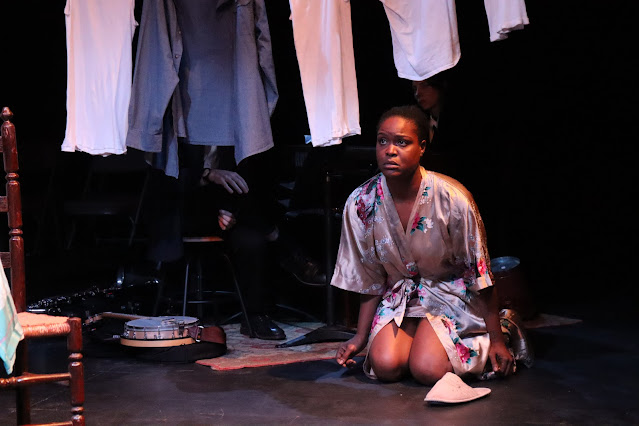Review: A Golem is Just One Family Issue in "Clay Mommy"
Clay Mommy
Written by Aviva Pearl Creation
Directed by Jael Scott
Presented at UNDER St. Marks
94 St. Marks Place, Manhattan, NYC
July 1-2, 2025
As a monster, the golem, a humanoid creature in Jewish tradition commonly created from mud or clay and animated via a word written on its forehead or on paper placed into its mouth, destabilizes normative boundaries and categories. A golem occupies the eponymous role of Clay Mommy in Aviva Pearl Creation's play of the same name, adding a complementary supernatural layer to the show's concern with such destabilizations, as well as with self-fashioning and mothering. With an all-trans-femme cast, Clay Mommy presents a nuanced narrative of one young woman's struggles to define and enact what it means for her to be a daughter and granddaughter, a prospective mother, a trans woman, and Jewish after she returns from New York City to the West Coast and her estranged mother. Clay Mommy is part of FRIGID New York's 2025 Queerly Festival, "FRIGID’s annual celebration of all things artistic and LGBTQIA2S+," which is currently curated by co-artistic director Jimmy Lovett and runs through July 3rd.In its conflicts and characters, Clay Mommy commendably avoids reductive, black and white binaries. Throughout the play, for instance, Violet and Lior face obstacles not only from bigotry and from men (embodied by puppets designed by Erma Fiend, aka Lee Friend, aka NYC drag king Sweaty Eddie) but also from hierarchization within the queer community, while the play also gestures to how hard it is to be a woman in general, whether cis or trans. Similarly, in addition to undermining more obvious boundaries, such as those which construct sex and gender, the play blurs the lines between 'good' and 'bad' mothers–one character describes a line of tough persevering moms, but looked at from another angle, as described by a different character, we see a line of mothers failing their children, a familial 'curse,' as Violet sees it, stretching back to the Holocaust. The present-day characters are all shaded and contradictory in very human ways, and the cast's performances ably capture these complexities. Violet can be loving, selfish, and impetuous, as Pearl Creation convincing and compellingly embodies her, while Lior is sweet and funny but also plagued by an undercurrent of rage, and the intensity that Taitano gives to a scene where Lior's anger boils over gains by its contrast to their prepossessing portrayal in the majority of the play. Baker-Lerner's often-funny Hana has her own anger mixed with her love, and not just because she was yanked out of the afterlife into a clay body; and Scott as Violet's mother balances a quick temper and sometimes outsized personality with woundedness and need for (re)connection. At bottom, much of Clay Mommy asks about what we need not only from others–friends, family (chosen or otherwise), and community (prayer and song help at several points to express characters' Jewish identities)–but also from ourselves in order to navigate our lives. In seeking answers to those questions, Clay Mommy posits that there is no divide between 'old life' and 'new life,' no past divorced from present, only a continuous, agonistic shaping of the messy clay of the individual.
-John R. Ziegler and Leah Richards




Comments
Post a Comment